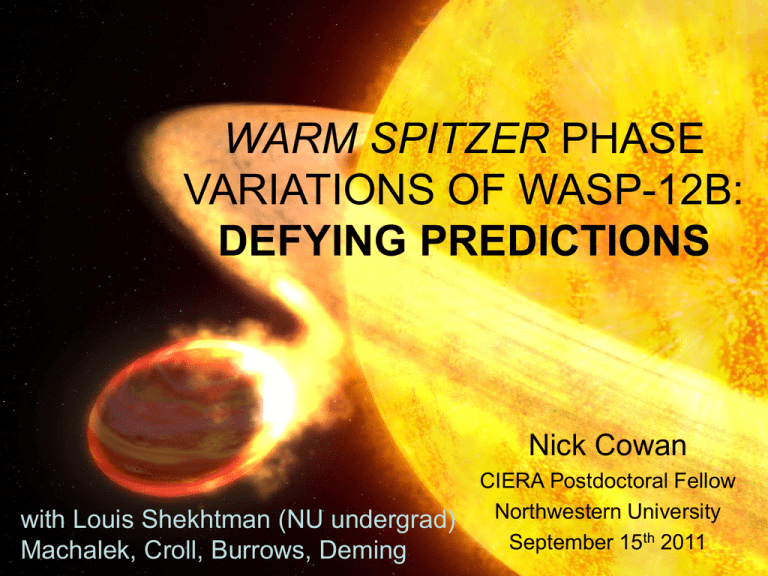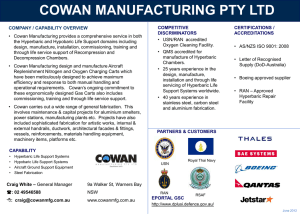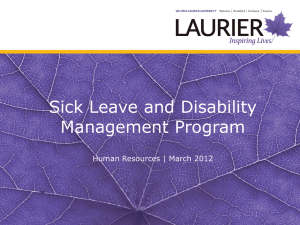Exo-Cartography (Time-Resolved Photometry of Exoplanets)
advertisement

WARM SPITZER PHASE VARIATIONS OF WASP-12B: DEFYING PREDICTIONS Nick Cowan with Louis Shekhtman (NU undergrad) Machalek, Croll, Burrows, Deming CIERA Postdoctoral Fellow Northwestern University September 15th 2011 WASP-12b: a Tortured World • • • • ~1 day orbit: Oblate Planet Tidally Warped: Prolate Planet Tday≈3000 K: MHD Effects Big Rp, small a: Roche-Lobe Overflow • Accretion on Star/ Bow Shock • Peculiar Eclipse Depths: High C/O ratio QuickTime™ and a decompressor are needed to see this picture. (Hebb et al. 2009; Ragozzine & Wolf 2009; Li et al. 2010; Lai et al. 2011; Leconte et al. 2011; Fossati et al. 2010; Vidotto et al. 2010; Llama et al. 2011; Madhusudhan et al. 2011) Check Out These Posters: Li et al. (2010) Sept 15, 2011 Crossfield 40.08 Petigura 33.03 Moses 40.04 Nick Cowan's Talk at ESS II 2 Thermal + Ellipsoidal Variations Optical Light Observations • Reflected Light Dominates Phases • Star’s Shape Dominates Geometry Infrared Observations • Thermal Emission Dominates Phases • Planet’s Shape Dominates Geometry Brightness Phases: Planet Light Geometrical Phases: Projected Area HAT-P-7b as seen by Kepler (Welsh et al. 2010) Sept 15, 2011 Nick Cowan's Talk at ESS II 3 Raw WASP-12b Photometry Phase Function Eclipse Eclipse 3.6 micron 4.5 micron Transit Intra-pixel sensitivity variations are the dominant systematic 1. Gaussian Decorrelation (Ballard et al. 2010) 2. Polynomial in Centroid x and y Sept 15, 2011 Nick Cowan's Talk at ESS II 4 WASP-12b at 3.6 micron Atherm/<Fp> = 0.9(3) Sept 15, 2011 Nick Cowan's Talk at ESS II max = -53(7)° 5 Increasing Heat Capacity 1) Decreases Thermal Phase Amplitude 2) Increases Hot Spot Offset Midnight SOP Sept 15, 2011 Dusk SOP Nick Cowan's Talk at ESS II Noon SOP Cowan & Agol (2011a) What Planets Are Supposed To Do Dawn SOP 6 WASP-12b at 3.6 micron Atherm/<Fp> = 0.9(3) max = -53(7)° Aellips = 2(2)x10-4 Sept 15, 2011 Nick Cowan's Talk at ESS II 7 WASP-12b at 4.5 micron Atherm/<Fp> = 0.7(1) max = -16(4)° Consistent with Cowan & Agol (2011a) Toy Model The Null Hypothesis Aellips = 1.2(2)x10-4 Sept 15, 2011 Nick Cowan's Talk at ESS II 8 Interpreting Ellipsoidal Variations Brightness Geometry Phases 4.5 micron phase variations most of cos(2) due cos(2) to geometry all due to geometry Spherical planet Temperature profile is cos(- 0) But applying Cowan & Agol (2008) deconvolution All of cos(2) due to temperature leads to unphysical longitudinal brightness map some of cos(2) due to temperature Sept 15, 2011 Nick Cowan's Talk at ESS II 9 Day-Side Emergent Spectrum Null Hypothesis (Campo et al. 2010) This Study (López- Morales et al. 2010) (Croll et al. 2011) Day-Side 1D Model Spectra (Burrows et al. 2007, 2008) Sept 15, 2011 Nick Cowan's Talk at ESS II 10 Transmission Spectrum (Maciejewski et al. 2011) Transit Spectrum Assuming Day-Like T-P Profile (Burrows et al. 2007, 2008) (Chan et al. 2011) Sept 15, 2011 Nick Cowan's Talk at ESS II 11 Choose Your Own Adventure 1. Prediction-Buster • Roche-Lobe Opaque at 4.5 m + Gravity Brightened Terminator • Weird Composition (not just high C/O) 2. Null Hypothesis • Ellipsoidal Variations As Predicted • Solar Composition? QuickTime™ and a decompressor are needed to see this picture. Sept 15, 2011 Nick Cowan's Talk at ESS II 12 WASP-12b Power Budget Eclipse Observations AB ≈ 0.25 ≈ rad/(adv + rad) ≈ 0.1 Phase Observations Hot Planets are Poor Recirculators (Cowan & Agol 2011b) 1. Magnetic Drag (Perna et al. 2010, Menou 2011) 2. Short Radiative Timescale (rad ≈ T-3) Sept 15, 2011 Nick Cowan's Talk at ESS II 13 EXOCLIMES 2012 Aspen, CO Jan 16-20, 2012 Registration Open www.aspenphys.org Sept 15, 2011 Nick Cowan's Talk at ESS II 14







